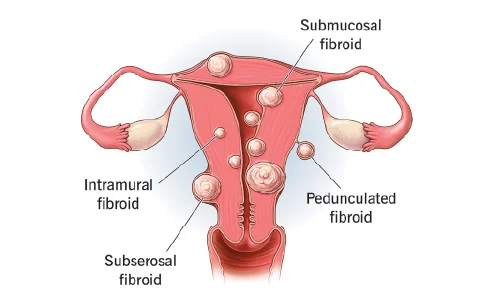- Home
- /
- Treatments
- /
- Uterine Fibroid Treatment in Noida
Uterine Fibroid Treatmentin Noida
Uterine fibroids are non-cancerous growths in the uterus, often causing symptoms like heavy menstrual bleeding, pelvic pain, and infertility. Treatments range from medication to surgery, addressing complications such as anaemia and reproductive issues.
If you're considering treatment for uterine fibroids, reach out to us or book a direct appointment with our gynaecologist. At the CK Birla Hospital, we are dedicated to ensuring that your uterine fibroid treatment is as safe, comfortable, and effective as possible. We're here to guide you every step of the way toward a successful recovery.
Uterine Fibroids: Risks, Type, Cause, Treatment & Cost

What are the Causes of Uterine Fibroids?
The development of fibroids remains unclear, but several factors may contribute, which are:
- Hormones: Oestrogen and progesterone, produced by the ovaries, play a role. These hormones prompt the regeneration of the uterine lining during menstrual cycles and foster fibroid growth.
- Family History: Fibroids may have a hereditary component. If a close female relative, such as a mother, sister, or grandmother, has experienced this condition, there is a likelihood of its development in others within the family.
Certain individuals have an elevated risk of fibroid development if they exhibit one or more of the following factors:
- A family history of fibroids
- Age 30 years or older
- High body weight
What are the Risks if Uterine Fibroids are not Treated Timely?
Uterine fibroids, common in childbearing years, may not always exhibit symptoms but can lead to health issues and other problems, such as:
- Increased Size and Number: Fibroids can enlarge and multiply, worsening symptoms.
- Menstrual Problems: Heavy bleeding or prolonged periods may cause anaemia.
- Pelvic Pain and Pressure: Discomfort interfering with daily life.
- Urinary Symptoms: Pressure on the bladder leading to frequent urination or incontinence.
- Constipation and Bloating: Fibroids pressing on the rectum can cause discomfort.
- Impact on Fertility and Pregnancy: Interference with fertility and increased pregnancy risks.
- Degeneration or Necrosis: Tissue death causing severe pain.
- Impact on Quality of Life: Emotional distress and decreased productivity.
- Rare Complications: Can lead to anaemia, infections, or torsion, which cause severe pain.
What are the Types of Uterine Fibroids?
There are various categories of uterine fibroids based on their location and attachment method. These include:
- Intramural Fibroids: These fibroids are situated within the muscular wall of the uterus and are the most prevalent type.
- Submucosal Fibroids: These fibroids develop beneath the inner lining of the uterus.
- Subserosal Fibroids: This variant of fibroid grows beneath the lining of the outer surface of the uterus and can expand significantly, protruding into the pelvis.
- Pedunculated Fibroids: This less common type of fibroid is connected to the uterus via a stalk or stem. They are often likened to mushrooms due to their stalk and wider top.
What are the Types of Uterine Fibroid Treatment?
Treatment for uterine fibroids is tailored based on various factors such as size, number, and location of fibroids, as well as the symptoms they cause. The various types of treatment include:
Medication Options:
- Over-the-counter pain relievers like acetaminophen or ibuprofen.
- Iron supplements to address anaemia.
- Birth control methods to manage bleeding and cramps.
- GnRH (gonadotropin-releasing hormone) agonists to shrink fibroids temporarily.
Surgical Options:
- Myomectomy: Removes fibroids while preserving the uterus. The available techniques are hysteroscopy, laparoscopy, or laparotomy.
- Hysterectomy: Removes the uterus, offering a permanent solution. The minimally invasive options are vaginal, laparoscopic, or robotic.
- Uterine Fibroid Embolization: Blocks blood flow to fibroids, reducing their size.
- Radiofrequency Ablation (RFA): Uses microwave energy to treat small fibroids.
It’s crucial to discuss treatment options with a healthcare provider, considering individual circumstances and preferences. Always consult before starting any new medication or procedure.
Advantages of Laparoscopic/Robotic Uterine Fibroid Surgery vs. Traditional Surgery
The advantages of laparoscopic/robotic uterine fibroid surgery over traditional uterine fibroid surgery are summarised below:
| Feature | Laparoscopic/Robotic Surgery | Open Surgery |
| Incision size | Small, keyhole incisions | Larger, single incision |
| Recovery time | Generally shorter | Longer |
| Postoperative pain | Typically less | Typically more |
| Hospital stay | Shorter (often same-day discharge) | Longer |
| Cosmetic result | Minimal scarring | More noticeable scar |
| Return to normal activities | Quicker | Slower |
However, the choice between laparoscopic/robotic and open surgery depends on individual patient factors and surgeon expertise. Each method has its own set of advantages and should be considered in the context of the patient’s overall health and specific circumstances.
Meet Our Doctors


What is the Diagnosis before a Uterine Fibroid Treatment?
In many cases, uterine fibroids are discovered during a pelvic exam, often prompted by symptoms like heavy bleeding. Diagnosis involves various tests, like:- Ultrasonography: Noninvasive imaging with sound waves.
- Magnetic resonance imaging (MRI): Detailed images using magnets and radio waves.
- Computed tomography (CT) scan: Detailed X-ray images from multiple angles.
- Hysteroscopy: A scope inserted through the vagina to examine the uterus.
- Hysterosalpingography (HSG): Detailed X-rays after injecting contrast material.
- Sonohysterography: Saline injection for clearer ultrasound images.
- Laparoscopy: Inserting a camera through a small incision for internal organ examination.
What are the Pre-treatment/surgery Instructions for Uterine Fibroids?
Pre-treatment and surgery instructions for uterine fibroids involve these key steps:- Consultation with a gynaecologist: Discuss treatment options and personalised recommendations.
- Medical management: Consider medication for symptom relief.
- Preoperative evaluation: Assess overall health and readiness for surgery.
- Preoperative instructions: Follow guidelines for fasting, medication, and anaesthesia preparation.
- Preparation for anaesthesia: Adhere to fasting guidelines and medication instructions.
- Postoperative care: Follow wound care, pain management, and activity restrictions.
- Follow-up care: Attend scheduled appointments for monitoring and addressing concerns.
What are the Post-surgery Instructions for Uterine Fibroids?
Post-surgery instructions for uterine fibroids typically include:- Activity restrictions: Steer clear of hard lifting, intense exercise, and physically demanding activities.
- Pain management: Use prescribed medications or over-the-counter pain relievers as directed.
- Dietary guidelines: Consume fluids, fibre-rich foods, and protein; avoid heavy or spicy foods.
- Follow-up appointments: Attend scheduled appointments for monitoring and further treatment if needed.
- Incision care: Keep incision sites clean and dry; watch for signs of infection.
- Resuming normal activities: Gradually ease back into regular activities.
- Medication management: Follow instructions for prescribed medications.
- Symptom monitoring: Be aware of new or worsening symptoms and report them promptly to healthcare providers.
How do You Recover after a Uterine Fibroid Treatment?
Recovery after uterine fibroid treatment varies based on the below-chosen methods:Surgery (e.g., myomectomy, hysterectomy)
- Rest and follow activity guidelines.
- Manage pain with prescribed medication.
- Care for incisions to prevent infection.
- Attend all follow-up appointments.
Minimally invasive procedures (e.g., uterine fibroid embolization, MRI-guided focused ultrasound surgery)
- Rest post-procedure.
- Manage discomfort with prescribed medication.
- Attend follow-up appointments for monitoring.
Medications (e.g., hormonal therapy, GnRH agonists)
- Follow medication instructions diligently.
- Monitor and report any side effects.
- Attend regular follow-up appointments for assessment.
Be a super-mom, stay informed about pregnancy health updates with our weekly newsletter
[contact-form-7 id=”16292″ title=”Subscribe”]
Frequently Asked Questions about Uterine Fibroid Treatment
What are Uterine Fibroids?
Uterine fibroids are noncancerous growths in the uterus that often appear during the childbearing years. Muscle and fibrous tissue make up these growths, which come in different sizes.
What are the Symptoms of Uterine Fibroids?
Symptoms can include heavy menstrual bleeding, prolonged menstrual periods, pelvic pain or pressure, frequent urination, difficulty emptying the bladder, constipation, backache, and leg pains.
Are Uterine Fibroids Cancerous?
Uterine fibroids are almost always non-cancerous, but in rare cases, a fibroid may contain cancerous cells. These are called leiomyosarcomas and are typically identified through imaging tests or after removal.
Can Uterine Fibroids affect Fertility?
Depending on their size and location, uterine fibroids can sometimes interfere with fertility. However, many women with fibroids can conceive and carry a pregnancy to term without any issues.
What is the Average Cost of a Uterine Fibroid Treatment?
The cost of a uterine fibroid treatment varies as per the specific type of treatment advised by a healthcare provider, such as:
- Myomectomy
- Hysterectomy
- Uterine fibroid embolization
- Radiofrequency Ablation (RFA)
- Medication
The cost can also vary widely depending on several factors, including the location, the extent of the procedure, the surgeon’s experience, and the hospital’s pricing structure.
To get an explicit estimate for the cost of uterine fibroid treatment at the CK Birla Hospital, contact the hospital directly. Additionally, you can consult with our board-certified gynaecologist to discuss your specific needs and receive a personalised quote for the procedure.






